| |  I’m back…
Hello all. It has been well over a year since my last column. Managing and playing for the U.S. Chess League expansion team and 2010 champion, the New England Nor’easters took some time, while the arrival of Zoe (10/22/10) has also taken up a bit of my time! I have no complaints on either front, but alas, it seems that it is time to start up the column again…
A friendly game
Very often we have to face our friends in tournament play. This may be at a local club, or it could be in a big money game in the last round of a major tournament. Sometimes playing against these too familiar opponents can be awkward. Maybe a draw is ok sometimes, but inevitably there comes a time when one must fight. And then sometimes a draw is ok, but a fight ensues anyway…
White: J.Fang
Black: D.Vigorito,
[D11] Queen’s Gambit Declined
NH op (2), 10.07.2010
Vigorito,D
IM Joe Fang is not only one of my best chess friends – he is one of my best friends, period. I had three groomsmen in my wedding, and Joe was one of them. But sometimes I have to try to kick his butt. Joe and I have probably played tens of thousands of blitz games, and this was our 22nd tournament game. In our first 9 games, 8 were decisive, with four wins apiece. The last of these games was in 1991. 11 consecutive draws followed, and most of these were admittedly short. In 2008 we had our first decisive game in 17 years. This game looked like it would be the next.
1.d4 d5 2.c4 c6 3.Nf3 Nf6 4.e3 Bg4 5.Qb3 Qb6 6.Nc3
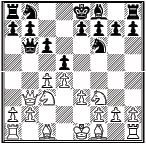
Joe plays the line recommended by Boris Avrukh in his excellent book Grandmaster Repertoire 2.
6...Bxf3
This is a bit unusual. Usually Black plays 6...e6, when the funny looking 7.Nh4 is Avrukh’s recommendation to hunt down the black bishop with h3 and g4.
7.gxf3 Nbd7
Black more frequently has tried 7...e6, but then 8.e4 takes the initiative in the center.
8.cxd5!
The point of Black’s play is seen after 8.e4 e5! when White has trouble maintaining control. I was also aware that IM John Watson had mentioned 8.Qxb6 Nxb6 9.cxd5 Nfxd5 10.Nxd5 cxd5 11.Bb5+ Kd8 12.Bd2 Rc8 13.Ke2 e6 14.Rhc1 Nc4 when Black is fine. Joe’s move is stronger.
8...Qxb3 9.axb3 Nxd5 10.Nxd5 cxd5 11.Bd2 e6 12.Bd3
White has a very small edge with the bishop pair and the open a-file, but it is not much. Perhaps 12.b4 Bd6 13.b5 would be better, to pin down the black a-pawn a bit.
12...Bd6 13.Ke2 Ke7 14.Rhc1 a6
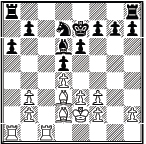
After the game, we realized we both would have pretty much been ok with a draw. I did not offer one because Joe had White in the first round and would likely be left with two Blacks, so I did not think he would accept. Joe figured I had about 150 rating points on him now, so I would not accept. In fact, especially considering the rather dry position, we were both ok with calling it a day. But no one offered (perhaps for the best!?). Here White can just kind of sit around, but Joe decided to go for it.
15.e4 dxe4
I saw the idea, but was not afraid. Instead 15...f6 was more solid, if a bit passive.
16.fxe4 e5 17.f4 f6
After 17...exd4 18.e5 Bc5 19.Be4 White’s bishop pair and advanced pawns give him excellent compensation.
18.Rg1 g6 19.dxe5
There are multiple ways to play for something. 19.fxe5 fxe5 20.Bg5+ Ke8 21.d5 was also possible.
19...fxe5 20.Bc3?
This looks for too much. Instead 20.f5 would allow White to maintain some pressure.
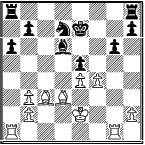
20...exf4!
I did not hesitate to play this. Immediately the tables are turned and White’s position becomes critical.
21.Bxh8 Rxh8
Suddenly all of Black’s pieces are better, and the kingside pawns are ready to roll. Black has more than enough for the exchange.
22.h3
Joe wanted to get the pawn off of a square where it was attacked, but this move should allow Black to create another passed pawn more easily. It is hard to offer advice however, as 22.Bc4 Ne5 23.Bd5 f3+ is very uncomfortable for the white king. Going to f2 drops the exchange back to …Bc5+, while Kd2 is met with …Bb4+. If the White king goes to the back rank, the rooks will be next to useless.
22...Ne5 23.Rgd1
Again 23.Bc4 f3+ is trouble.
23...g5 24.Bc4 h5
I wanted to get the pawns moving, but 24...Rc8!? was good too.
25.Ra5
Joe cannot defend by normal means, so he must activate his pieces and hope for a tactical opportunity.
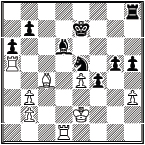
25...Rh6?
I spent a long time on this move. Joe was very critical of it after the game, but I though it made sense. I hesitated to play 25...g4 because of 26.Rxd6 (not 26.Rdd5 f3+! 27.Ke3 [27.Kf2 g3+] 27...Nc6μ) 26...Nxc4 27.bxc4 Kxd6 28.Rg5

Here I thought it would be difficult to win because it is difficult to maintain the advanced pawns without them becoming blockaded. In fact I can play 28...gxh3! when White needs time to round up the pawn, and Black can strike on the other side, for example: 29.Kf3 Ke6 30.Rf5 h2 31.Kg2 Rd8 32.Kxh2 Rd2+ 33.Kh3 Rxb2–+
Another good idea would have been 25...Bb8!? 26.Rdd5 Kf6μ keeping all of Black’s positional advantages intact.
26.Rdd5
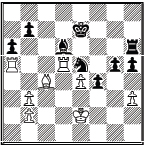
26...b5??
A total meltdown. As soon as I moved I saw the gaping hole in my calculations. It was better play 26...Nc6. Here we both thought during and after the game White would be reduced to 27.Rxg5 Nxa5 28.Rxa5 b5 29.Bd5 Bc7 30.Ra1 Rg6 when Black still has good chances to play for a win. In fact White could hold rather easily with 27.Rxd6! Rxd6 28.Rxg5=.
27.Rxa6 f3+
If 27...bxc4 28.Rxe5+ exploits the loose rook on h6, so suddenly Black is lost. Oops.
28.Kf2 Nxc4 29.Ra7+
There are many ways. 29.bxc4 Bc5+ 30.Rxc5 Rxa6 31.Rxb5+- is also pretty convincing.
29...Ke8
29...Kf8 30.Rf5+ wins.
30.bxc4 g4 31.Rg5 Kf8 32.c5
I was the most worried by this move, but the simple 32.cxb5 was probably best, while 32.Rf5+ Ke8 33.c5 also wins handily.
32...Be7 33.Rf5+ Rf6
Hoping for a miracle.

34.Rxe7??
And there it is. In time pressure Joe has his turn with a hallucination. I had seen 34.c6 Rxf5 35.exf5 Bc5+ 36.Ke1 Bxa7 37.c7 and lights out.
34...Kxe7 35.Rxf6
Also drawing is 35.b4 Rg6 36.hxg4 hxg4 37.Kg3 Kd7.
35...Kxf6 36.hxg4 hxg4
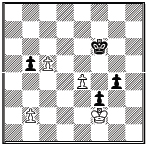
Joe had realized that the white pawns protect each other, but then cannot advance.
37.c6 Ke7! 38.e5 Ke6 39.Ke3 b4 40.b3 Ke7 ½–½
White: R.Hungaski
Black: D.Vigorito
[B25] Sicilain
USATE Parsippany (3), 20.02.2011
IM Robert Hungaski is a big talent and I was well aware of this. Robert was the team MVP for the New England Nor’easters. He entered the season with a 2420 rating although by the time the season started he was 2500+. In his 8 games for the Nor’easters Robert posted a 7/8 score with a 2780 performance rating, including 3-0 in the playoffs. He beat such players as Denys Shmelov, Jorge Sammour-Hasbun, FM Marcel Martinez, and GM Pascal Charbonneau. The wins were not always flawless, but Robert is a complete gamer and displayed tremendous energy and a will to win. Robert would drive 2 hours from Connecticut each week in his jalopy and never complained. He’s just a cool dude with great energy.
At the USATE in NJ Robert came up to me during the first round and it was very good to see him, as we had not run into each other since the USCL Finals. The sight of him was less pleasant when we were paired against each other the next morning…
1.e4
This move already requires a little explanation. Robert leans a bit more towards 1.d4 these days, but back in November a young 2100 student of mine pushed Robert to the brink of defeat in the B.U. Open with the Slav Defense. Although Robert managed to win anyway, I imagine the memory of this game may have come to mind. Robert took some time on his first move, perhaps figuring if my student did so well with the Slav, I may be tough to beat. As I was Black in a team event and I was the only one paired up, a draw would not be a bad result for me. Even so, I did not want Robert to be able to push ‘for free’, so I planned on playing the King’s Indian!
1…c5!
In the USCL I had defeated FM Brooks with the Caro-Kann. Perhaps Robert’s first move had taken that game into consideration.
2.Nc3
The Closed Sicilian. While this is a reasonable way to play, the advantage of White’s first move is quickly negated.
2…Nc6 3.g3 g6 4.Bg2 Bg7 5.d3 d6 6.f4 e5 7.Nh3
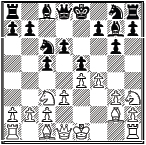
This is a tricky move, but I still do not think much of it. The knight ends up getting stuck here.
7...Nge7 8.0–0 Nd4!
White’s point is that after 8...0–0? 9.f5! Black comes under a strong attack. By playing 8…Nd4 immediately, Black does not present his king as a target just yet. The knight also reinforces the f5-square and puts some pressure on c2.
9.Qd2!?
This is very odd indeed. White blocks in his own bishop. The idea is to play Nd1 and c3, but this is not that scary.
9...Bg4!?
I like this move. The bishop goes to a square that it would not normally have access to and from here it controls f3 and e2, so it gives White a lot to think about. 9...0–0 is also fine.
10.f5?!
This is too speculative. 10.Nd1 is still possible, while 10.Nf2 would be met with 10…Bf3! (but not 10...Nf3+ 11.Bxf3 Bxf3 12.Qe3 Bh5 13.g4 and the bishop is trapped).
10...gxf5 11.exf5 Bxf5
11...Nexf5 was possible too, but I prefer the text.
12.Ne4 d5! 13.Qg5
Another speculative move, but White has made his bed. Instead 13.Nxc5 Qc8! attacks both white knights.
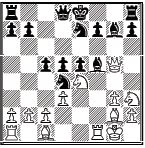
13...Kf8!
I had intended 13...Ne6 14.Nf6+ Kf8 15.Qh4 Ng6?! but then 16.Nxh7+ (it took me a while to notice this) 16…Kg8 17.Qxd8+ Rxd8 18.Rxf5 Rxh7 19.Ng5 and White has won back his pawn and activated his position. By moving the king, Black ensures that Nf6 by White will never be check, so Black will have new possibilities.
14.g4
The point of Black play is seen after 14.Nf6? h6 15.Qh4 Ng6. 14...h6 15.Qh4 Bg6 16.Nxc5 Qc8 17.Nb3 Nxc2 18.Rb1 Bxd3 It is time to take pawns. White’s next move came as no surprise from a practical player like Robert.
19.Bd2
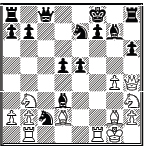
White is already down a couple of pawns, so adding an exchange does not matter.
19...a5!
Black has enough material to win, and there is no reason to be greedy at the cost of one’s position. This stops any Bd2-b4 ideas, ...a4 is possible, and most importantly ...Ra6 is useful to both defend the king and possibly go to c6 to break any pin along the c-file. Instead 19...Bxf1 should be winning as well, but it allows White greater swindling chances. If I take the rook, I am essentially trading my strong bishop for the passive b1-rook. The bishop protects the c2-knight and may come back to g6 to defend f7. Now White is down material but has trouble getting any initiative at all.
20.g5?! hxg5 21.Qf2 f6 22.Bxg5 Bf5
This move blocks the f-file and attacks the h3-knight. 22...Ra6 23.Nc5 Bxf1 24.Rxf1 Rc6 was also possible
23.Rbc1 Ra6 24.Be3 d4 25.Bxd4
There is nothing else. 25.Bd2 Bxh3-+
25...exd4 26.Nxd4 Bxh3 27.Rxc2 Qg4 28.Qe3
Now Black is up a piece for basically nothing. I only have to be a bit careful, but I was very short on time.
28…Rh4?
This natural (well, to me at least) move is a big mistake. Instead 28...Rd6 was good, while 28...Bh6! with the idea 29.Qxh3 Qxh3 30.Bxh3 Be3+ was probably the best of all.
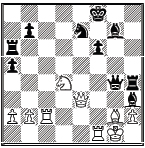
29.Nf5!
I had in fact seen this move, but I had missed a little something…If 29...Nxf5 30.Rc8+ Kf7 runs away, but I missed 31.Qe8#!
29…Qxf5!
With time ticking down I find a way. Of course it was better to be up a whole piece, but Black will still have rook and two minors for the queen.
30.Rxf5 Bxf5
Black is still clearly better, but I had 2 minutes to White’s 8. Fortunately Robert needed some time here and I was able to calculate while he was thinking.
31.Rc7 Re6 32.Qf2
This freaked me out a bit and I fell into a trance, almost completely forgetting about the clock.
32.Rh5
Now I was down to 48 seconds.
33.Qd4 Bh6!
Black's attack is stronger.
34.Qd8+ Kf7 35.Bd5 Be3+ 36.Kg2?
Now down to 11 seconds himself, Robert comes undone. If 36.Kh1 Be4+ 37.Bxe4 Rxe4–+ is winning. 36.Kf1 Bh3+ 37.Ke2 Rxd5 (honestly I had intended 37…Bb6+ when 38.Bxe6+ is both uncheck for me and check for him! I like to think I would have realized this had the position arose…) 38.Rxe7+ Rxe7 39.Qxd5+ Kg7–+ when Black is winning, but there is work to do.
36...Rg5+ (time pressure)
I made this move with 8 seconds left and White lost on time. It is mate after 37.Kf3 (37.Kh1 Rg1# or 37.Kf1 Bd3+ 38.Ke1 Rg1#) 37...Bg4+ 38.Kg2 Be2+ 39.Kh3 Bf1+ 40.Kh4 (40.Bg2 Bxg2+ 41.Kh4 Bf2#) 40...Bf2#.
0–1
The MA G/60 Championship brought me out of my semi-retirement.
White: D.Vigorito
Black: W.Kelleher
[D10] Queen’s Gambit Declined
MA G/60ch (3), 17.04.2011
Vigorito,D
Bill Kelleher is another good friend who I have known for 20+ years. He is difficult to play against because even though he has a relatively narrow opening repertoire, he knows it really well and has built up impressive experience in all of his pet lines.
1.c4 c6 2.d4 d5 3.Nc3 Nf6 4.cxd5 cxd5
The Exchange Variation is pretty harmless, but I did not have anything special prepared in any ‘real lines’ despite having many years to come up with something. Laziness!
5.Bf4 Nc6 6.e3 Bf5 7.Qb3
This is a tricky sideline that I had used only once before with success… against Bill! Instead 7.Nf3 heads for the normal (equal) lines.
7...Na5 8.Qa4+ Bd7 9.Qc2!
This is a little annoying for Black although it should not be too scary. 9.Bb5 has been played a lot more, but exchanging light-squared bishops should never give White anything. I discovered this line when I faced it a few times on the ICC against some GM.
9...Rc8 10.Bd3 e6 11.Nf3
White’s idea is revealed. Even though he has wasted some time with the queen, Black has had to lock in his queen bishop. Still, the Exchange Slav lines with an early …e6 are not so bad, and Black’s …Na5 move is kind of normal to get some queenside play going.
11…Nc6?!
This is a new move, but it is too passive. I suspect Black should just develop with 11...Be7 or 11...b5 12.a3 Be7.
Instead practice has seen 11...Bb4 12.0–0 and here:
a) 12…0–0 13.Ne5 Bxc3 14.bxc3 h6 15.h3 Nc4 16.Bxc4 dxc4 17.e4 Be8 18.Rab1 b5 19.Rfd1 Nh5 20.Bc1!? f6 21.Nf3 and White had a nice edge in D.Vigorito-W.Kelleher, NH Open 2007.
b) 12...Nc4 13.Bxc4 Rxc4 14.Ne5 Rc8 15.Qb3 Qa5 16.Nxd7 Nxd7 17.a3 Bxc3 18.Qxb7! was also good for White in V.Kramnik-L.Aronian, Shanghai (blitz) 2010. No slouches!
12.a3 Nh5?!
This is not an unusual idea, but it does not work out well here. Again, 12...Be7 was called for.
13.Bg5
Now Black is uncomfortable.
13...f6?
After 13...Be7 14.Bxe7 Qxe7 White has a pleasant edge with 15.0–0, while 15.g4!? Nf6 16.g5 would also be tempting.
14.Bh4
I played this quickly, but it was simpler to play 14.Bxh7! fxg5 15.Qg6+ Ke7 16.Qxh5 when Black has no way to exploit the pin on the h-file.
14...g5
This was a G/60 and I was a good 10 minutes ahead on the clock. I used up all of that time here, as I had to decide…
15.Nxg5!
This is absolutely correct, although my opponent could have given me some practical issues. Instead 15.Bxh7 gxh4 16.Qg6+ Ke7 17.Qxh5 is not so good now because of 17…Be8 18.Qxh4 Bg6, even though White probably has enough after 19.Bxg6 Rxh4 20.Nxh4. I could also consider 15.Bg3!? with the idea 15…Nxg3?! (Black should hold off on this) 16.hxg3 f5 17.g4!±.
15...fxg5 16.Bg6+ Ke7
Not 16...hxg6 17.Qxg6+ Ke7 18.Bxg5+ Kd6 19.Nb5 mate!
17.Bxg5+ Nf6 18.Ne4!
18.Ne4!
This is the key move which I had to see (and sees!) at move 15. I found this idea by first noticing the unsuccessful 18.Nxd5+?? exd5 (now Black has a square) 19.Qc5+ Ke6!
18...hxg6?
This loses academically. The critical line was 18...Qa5+. When I first noticed this during my big think, I thought it would be a shame if a move like 18.Ne4 did not work. So I kept trying… After 19.b4 dxe4 (not 19...Nxb4 20.Bxf6#) 20.bxa5 hxg6 (20...Nxd4 fails to either 21.Qxe4 or 21.Bxf6+ Kxf6 22.Qb2) 21.Qxe4
Here Black has 3 minors for the queen and some pawns. The computers think it is easy, but in a fast time control White will have to be very accurate. A good start would be 21...Kf7 22.Bxf6 Kxf6 23.Rb1 and White should be winning.
19.Bxf6+ Kf7 20.Bxd8 Nxd8?!
A better try was 20...dxe4 21.Bg5 Nxd4 22.Qxe4 Nc2+ 23.Kd2 Nxa1 24.Rxa1, but this should be pretty easy too.
21.Nc3!
Now Black has only two minors for the queen and pawns. Black could give up, but with the momentum of the fast time control, the game continues. I probably did not play too precisely, but it was good enough.
21…Bd6 22.h4 Kg7 23.Qe2 Nf7 24.f4 Be7 25.h5 g5 26.g4 Nd6 27.0–0 Kh6 28.e4 Rxc3
This is actually the best practical chance. If 28...dxe4 29.Nxe4 Bb5 30.Qe3.
29.bxc3 Nxe4 30.c4 Bf6 31.Qd3 Rg8 32.f5
32.Rae1 may have been more accurate.
32...exf5 33.cxd5 Nd6 34.Rad1 f4
If 34...Bb5 35.Qg3 f4 36.Rxf4!
35.Qf3 Nb5 36.Rfe1 Nxd4
37.Qf2 Nb5 38.Re6 Bxe6 39.dxe6 Nc3 40.Rd7 Rg7 41.Qc2 1–0
IM David Vigorito is the author of several highly acclaimed books. Signed copies are available, and he can also be reached for private and group lessons, lectures, and exhibitions at dvigorito@msn.com.
|